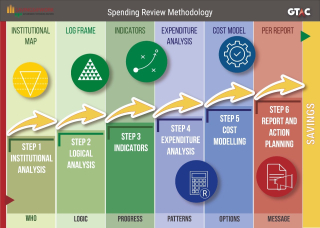
Posted by Ronette Engela, Robert Clifton, Martin Johnson, and Nellie Coopoosamy [1]
Expenditure baselines may be defined as the cost of delivering public services consistent with the government’s policy mandates. Baselines are the starting point for developing forward estimates and managing the budget. Ministries can apply cost drivers to estimate changes in the baseline and focus attention on adjusting budgets in line with available fiscal space. In practice, budgets do not necessarily reflect the true cost of delivering mandated services. Baseline problems are reasonably well understood in advanced countries, where spending reviews regularly interrogate these baselines, but much less so in low-capacity countries. Once set, a baseline can ‘lock-in’ funding for mandates whether appropriate or not.
In such an environment, budget officials are left with an uncomfortable feeling that ‘something is wrong with the baseline’ but they are not sure precisely what is wrong, nor how to resolve the problem. The information asymmetry between finance and spending agencies doesn’t help. To keep the budget machine going, officials often proceed on the misleading assumption that last year’s baseline is more-or-less correct or, in periods of fiscal constraint, initiate blanket cuts that ignore baselines and do not differentiate efficient from inefficient programs, and between policy priorities.
An alternative approach that has recently been developed in South Africa focuses on investigating so-called ‘pocket problems’, which do not require countries to carry out a comprehensive spending review. A ‘pocket problem’ is a digestible and manageable budgeting issue whose full costs can be assessed, waste and inefficiencies identified, and severe funding constraints recognised. Policy and program logic is examined in depth and combined with readily available expenditure data from the government accounting system. Through a series of clear, understandable and systematized steps, small-scale spending reviews are developed[2].
Pocket problems are not ambitious statements of high-level policy goals. They are real and identifiable components of policy initiatives and delivery programs that have clear boundaries. Framing a problem well puts analysts on the path to solving it.
The whole process takes approximately six weeks and is undertaken by budget officials in conjunction with program managers. It is accepted that the entire baseline cannot be fixed in a single budget cycle. Instead, officials are encouraged to ‘feel their way’ to the baseline by incorporating a pocket problem approach in their annual work cycle, and to build up these cases gradually over time.
In January 2020, Afritac South used elements of the South African pocket problem approach to train officials from the Ministry of Finance, Trade Investment and Economic Planning (MoFTIEP) in the Seychelles to develop a more reliable spending baseline. The training—which comprised four steps—demonstrates the importance of ‘learning by doing’, rather than waiting for a perfect methodology and perfect data sets.
- Pocket problem identification and unpacking
- Logical framework development
- Expenditure analysis
- Presenting early results and identifying next steps
In the case of Seychelles, a list of 12 pocket problems was prepared. Budget officials then analyzed the logic underlying these policies, to better understand the rules, procedures and incentives faced by program managers in delivering services and the choices made by these managers. Using a simple guide, officials then drew up a standardised logical framework for each of the pocket problems. The analysis provided an information base for budget officials to assess expenditure patterns. They looked at aspects such as the flow of funds, analyzed expenditure in terms of organizational units, and the relationship between inputs and outputs. Guided by these insights, expenditure data was then combined with available performance and administrative information to generate early indications of input unit costs. In the South African experience, this phase of analysis has become standardised and a set of standardised steps assist analysts.
This approach deliberately takes budget officials out of their comfort zone of budget numbers and into the service delivery space of program managers. By linking policy logic and the activities used to deliver services, officials obtain a much better sense of how and why resources are deployed and where inefficiencies might be found. This reduces the information asymmetry between the central budget office and spending agencies.
Budget officials will follow up this work in the FY2021 budget process in four specific areas: (i) police vehicle fleet management; (ii) coast guard ship maintenance; (iii) drug-addiction treatment; and (iv) road maintenance. It is hoped that other developing countries will follow suit.
At a time when budget officials the world over are coming to terms with COVID-19 related fiscal shocks, a ‘pocket problem’ approach may be useful in estimating the cost of vital COVID-19 responses.
[1] Ronette Engela, Head of Public Expenditure and Policy Analysis, Government Technical Advisory Center (GTAC), National Treasury, South Africa; Robert Clifton, PFM Advisor at Afritac South;; Martin Johnson, PFM expert; Nellie Coopoosamy, Director, Public Budget Management, MoFTIEP, Seychelles.
[2] A manual on the methodology of doing this type of spending reviews in South Africa has been prepared and forms part of a two-week training course delivered by GTAC, National Treasury.
Note: The posts on the IMF PFM Blog should not be reported as representing the views of the IMF. The views expressed are those of the authors and do not necessarily represent those of the IMF or IMF policy.






